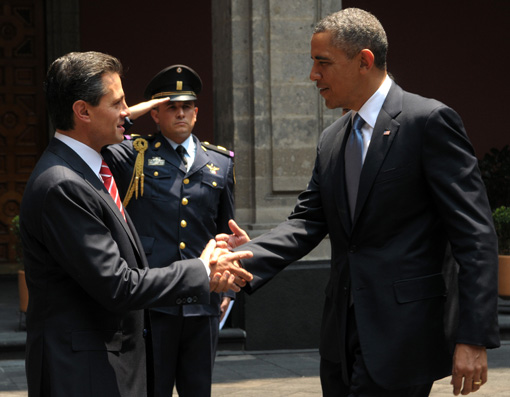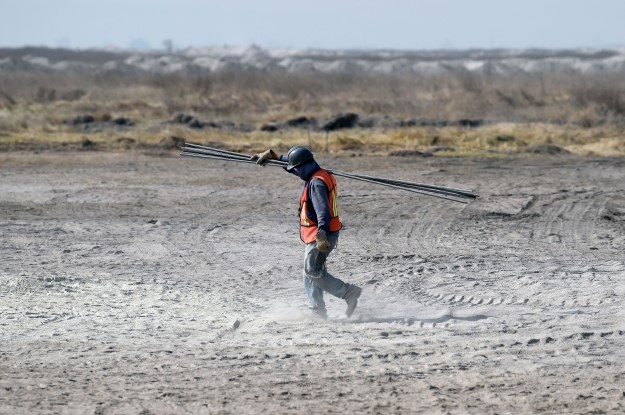Latin America, and Mexico in particular, are quickly emerging as new and unexpected partners of Washington’s global strategy, including its Asia pivot. Last month, Chilean President Sebastian Piñera and Peruvian President Ollanta Humala visited Washington soon after President Barack Obama completed a trip to Mexico and Costa Rica. Vice President Joe Biden had returned from a three-country Latin American tour one month earlier.
Although a strong link may not initially appear evident between the White House’s Latin American overture and its Asian focus, the parallels are more apparent upon closer analysis.
In a global context where Europe continues to shift from one crisis to the next, the Western Hemisphere, like Asia, represents a potential partner for furthering economic growth, building political partnership and balancing China’s global leadership. This strategy may look like an abrupt conversion, but, from a historical perspective, it is easy to see how the administration’s Latin American turn is consistent with precedent.
After 1933, with Europe torn by emerging nationalism, then-President Franklin Delano Roosevelt turned to Latin America for global partnership. It was a wise decision.
The economic and political relationships that were forged under the auspices of the Good Neighbor Diplomacy created a cohesive block that helped to defeat Nazism and lasted until the beginning of the Cold War. During the 1930s and 1940s, Pan-Americanism’s ascent granted Western Hemisphere countries, including the United States, an extraordinary period of economic, social and democratic harmony.
The new attention to the Western Hemisphere today, along with continued global economic and political challenges, creates the conditions for a new Pan-American season. What are the motives, objectives, reciprocal opportunities and challenges implicit in the administration’s new Latin American position?
The Case of Mexico
Like many other Latin American economies, Mexico cruised through the Great Recession with extraordinary resilience, with an average 4 percent rate of economic growth in recent years. Following the economic turmoil after the explosion of the debt crisis in 1982 and the socially devastating neoliberal recipes adopted during the subsequent decade, over the last 15 years, Mexico has enjoyed firm macroeconomic stability and an increasingly democratic, institutional solidity.
Unlikely many European or American peers, thanks to efficient regulation undertaken during the 1990s, Mexico’s financial system has proven to be in great shape, with banks well capitalized and minimal exposure to risky credit. Debt is under reasonable control and past administrations have run no fiscal deficit.
Moreover, the enactment in 1994 of the North American Free Trade Agreement (NAFTA) with the U.S. and Canada strongly increased the country’s industrial output and firmly integrated Mexican production into the U.S. market. Mexico’s manufacturing is no longer exclusively related to labor-intensive activities. In recent years, the country’s industrial production has registered an important technological evolution and Mexico has become a global leader in high-tech manufacturing, including automobile production.
Since the approval of NAFTA, the Mexican and U.S. economies have become deeply integrated. This not only means an increase in the trade of goods but, unexpectedly, the two countries have also begun to build products together. In many cases, Mexican, American and Canadian industries produce and assemble parts that cross national borders several times before becoming a final product.
The re-shoring practices of many industrial companies have accelerated this phenomenon. Companies that had previously decentralized their production in Asia (especially in China) are now relocating to Mexico, the United States and Canada. Recent increases in Chinese workers’ wages and in oil prices have made countries like Mexico more attractive to investment. At the same time, Mexican salaries have remained stable during the last decade and transport across the border has become consistently cheaper than moving goods from China.
The high integration of joint production has allowed the three countries to effectively use these comparative advantages and function almost like a single nation. NAFTA countries have also benefitted from joining several trade treaties, which allows production to reach numerous foreign markets in Latin America, Asia and Europe. As a result, manufacturing in North America seems to have regained its competitiveness.
A primary objective of the Obama administration in Mexico is creating the political conditions for a dramatic enhancement of economic integration with the objective of making American production more competitive in global markets. The creation of new jobs and long-term, stable economic growth for both countries are strictly tied to the success of this project.
The 2011 election of President Enrique Peña Nieto of the Partido Revolucionario Institucional (Institutional Revolutionary Party—PRI) has represented an incentive for Washington’s new approach to the country. Peña Nieto’s predecessor, Felipe Calderón, had mainly focused bilateral relations on security assistance. Economic growth is the main objective for Peña Nieto, and economic cooperation a top agenda item with the United States.
Political bargaining and negotiation skills are part of the PRI’s genetic code and during his first months in power, Peña Nieto has shown his adeptness at finding solutions. After his electoral victory, the new president developed a vast reform plan, Pacto por México, and managed to bring the two main opposition parties on board.
In just a few months, Congress passed education, finance and telecommunications reforms. It is possible that in the coming months Congress could pass a radical reform of the energy sector which, following the Brazilian example, could open Mexican state-owned Pemex to foreign investments thus boosting its exploration capacity and production level. The tax-system reform, which according to Finance Minister Luis Videgaray will enhance the Mexican fiscal base, is another strategic piece of legislation that Congress should soon start to debate.
The reformist attitude that marked Peña Nieto’s first months in power seems to complement Obama’s new Latin American turn. Within the context of strong institutional stability granted by the Pacto por México, the new PRI government’s reforms aim to dramatically lower credit prices and energy costs, thus perfectly fitting in with Obama’s idea of making the NAFTA area one of the most competitive in the world. This could result in mutual benefits in terms of economic growth, jobs and poverty reduction in Mexico if the two countries can promote more economic integration.
But some caution is needed as well. Lingering challenges may arise with the U.S. administration’s one-track economic approach, and may also threaten Mexico’s path to sustainable development.
For one, the image being painted of Mexico—a vibrant democracy and manufacturing powerhouse which through technological innovation is empowering a new young and well prepared generation—is an over simplification.
This is a picture that is also completely oblivious to the numerous social and institutional problems that the country is still facing. The administration seems to be underestimating the serious implications of Mexico’s persistent inequality on the stability of the political system and the fact that the country has not yet completed its transition to a full democracy.
Mexico’s recent economic success has not yet produced satisfactory results in terms of poverty reduction—an urgent problem in a country with one of the highest levels of inequality in Latin America. New data released from the Consejo Nacional de Evaluación de la Política de Desarrollo Social (National Council for Evaluation of Social Development—CONEVAL) show that poverty increased from 52.8 to 53.3 million Mexicans from 2010 to 2012.
The new promises of economic growth that form the backbone of further economic integration with the United States will not automatically reduce Mexico’s poverty gap. Between 1948 and 1980, during the years of the so called “Mexican Miracle,” the Mexican economy substantially increased its industrial core and GDP expanded, yet inequality and poverty did not significantly decrease.
Beyond the crucial ethical problems that it poses, inequality also represents a time bomb placed under Mexican stability. It is the main generator of many of the problems that dramatically affect the country today, including insecurity and narcotrafficking.
The Peña Nieto administration has recently launched a new program, Cruzada conta el Hambre (Crusade against Hunger), which, along with other targeted policies that follow the successful Brazilian experience, aims to balance the provision of basic food with education and social inclusion. It is still too early to assess the results. However, opposition parties have already claimed, and in some cases proved, that the PRI is using these policies in a clientelistic way rather than as effective tools in its fight against poverty.
If Washington really wants a stable partner for enhancing economic integration on its southern border, it should address the problem of wealth redistribution as part of its new strategy toward Mexico. The idea that a poor Mexico provides U.S. industries with a cheap labor force is shortsighted and dangerous. It leads to Mexican political instability and violence and is at the root of challenging domestic problems.
The two countries have to work on mechanisms and programs that, along with more economic integration, can create the conditions for sustainable, social development in Mexico. During the 1930s and 1940s, along with policies aimed to enhance economic cooperation, Washington successfully used the Export-Import Bank to fund important infrastructural programs to boost Mexico’s economic development.
The U.S. administration should look at the experience of that integrated policy for an inspiration of its own and use some of the tools already at its disposal to implement it. For example, in 1994, NAFTA created the North American Development Bank (NADB), an institution funded by the two countries and originally aimed to improve environmental and social conditions along the U.S.-Mexican border. Unfortunately, the bank has a low capitalization and its potential has not yet been fully reached. Strengthening NADB and expanding and its mandate could be good starting points to tie economic integration and social improvement in Mexico.
Secondly, even if Mexico has made substantial progress in terms of democratization, its political system has not yet completed a full transition to democracy. Widespread corruption, clientelism and lack of transparency and accountability still dramatically affect Mexican politics.
Corruption ranges from low-scale incidents of police bribery to acts that taint presidential elections. The 2012 presidential election was no exception, with opposition parties overtly accusing the PRI of delivering prepaid gift cards to voters in exchange for their support. Even though the Instituto Federal Electoral (Federal Electoral Institute—IFE) ruled that the PRI did not engage in vote buying, the IFE made no serious efforts to lead an independent investigation. The July elections for governors, legislatures and mayors in 14 states were marked by violence, reports of using public funds to buy votes and other irregularities.
The new bilateral partnership should include mechanisms to encourage Mexico’s unfinished transition to democracy. This means, for example, encouraging Mexico to increase the quality of its administrative processes and the enhancement of anti-corruption mechanisms. But it also means supporting Mexican civil society, creating independent bodies with control over political and administrative processes, and defending the Mexican free press from political interference and the threat of narco-violence. The positive effects of a more transparent, less corrupt Mexican state are incalculable for Mexico and, in turn, for the idea of enhanced economic cooperation.
Sustaining Mexico’s fight for social inclusiveness and helping to enhance its democratization process are not an easy task. Mexico has traditionally and understandably been reluctant to accept interference in its internal affairs, especially from its powerful neighbor. However, the reformist season opened by the Pacto por México and the sensibility shown by the Obama administration open a new, yet unexplored opportunity for mutual cooperation. It could be the beginning of a new Pan-American season, and it would be regrettable, for both countries and the continent, to waste this great opportunity.








